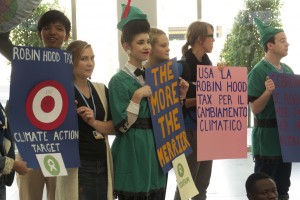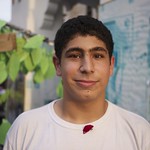Search Results for Tag: cop18
2012 in review from a climate change perspective
At the end of the year you get flooded with reviews of 2012. We won’t bore you with another one. Well, we can’t do without revisiting last year at all. So here are some interesting bits and pieces of info on what happened in 2012 from a climate change perspective.
Oil and coal are set to be phased out sooner or later, scientists are busy exploring alternatives. One of them comes straight from the gut. No kidding. In January they presented genetically engineered gut bacteria that could convert seaweed into ethanol. If the process is feasible on large scales, this may help solve the fuel-versus-food- dilemma.
Flood protection for coastal areas, habitat to thousands of species: coral reefs maintain several critical roles in the Earth’s ecosystems – some of which are under particular threat due to climate change. But at the same time corals themselves are threatened by global warming, as NASA scientists confirmed in February following one of the most comprehensive studies yet undertaken on the issue. Rising water temperatures and increasing acidification lead corals to dissolve and die – and the loss of their protective role.
But there is also good news: There is a shift in the climate change debate – from “does climate change exists?” we’ve moved on to “what impacts does climate change have?” and in the best case “how can we prevent it?”. March saw the public discuss a question – well in line with this new level of awareness: Has climate change been underestimated so far? Scientists warned, the global mean temperature could rise by 3 degrees Celsius by 2050.
Climate change is not an isolated problem, but associated with other issues – like food security for example. So, in April, experts and locals discussed at the Climate Smart Agriculture in Asia workshop how to secure rice production in a warming world with more intense droughts and rainfalls. Rice is the staple diet for more than half of the world’s population. At present some 870 million people are already suffering from hunger – not to imagine how this situation will worsen if rice production falls short.
In May world leaders met in Bonn for climate conference – but were not able to agree on any effective measures.
At least a little more optimism could be found at the Rio+20 conference in June: Our reporters Kerstin and Philipp were there for you, presenting innovative people, their ideas and opinions. Re-experience their trip here.
To mitigate global warming, researchers also come up with controversial ideas – most of them attempts to fix the climate by resorting to geoengineering. One idea was highly disputed in July: by dumping iron into the ocean, the ocean’s ability to act as a carbon sink should be increased.
Even some climate skeptics were finally convinced of the reality of climate change, when severe droughts and heat waves hit the United States in the summer months around August. Russia also suffered from extreme droughts, but for the US 2012 has been the hottest year ever recorded.
From dry and hot regions to cold ones: in the middle of September the Arctic ice cover reached an all-time low. Ice melting during the summer is not unusual, but the rate of melting and the large area affected astonished researchers.
Watching the densely populated US East coast brace for the impact of super hurricane Sandy in October, many people around the world paused – the effect of climate change appeared so undeniable as hardly ever before: More and more people in the United States – the developed country with the highest CO2 emissions per capita – start believing that climate change is real.
Following the strong winds, in November researchers declared that sealevels are rising quicker than expected: in fact, the oceans are rising 60 percent faster than previously thought.
In December super-thyphoon Bopha hit the Phillipines, being far stronger than the storm that killed more than 1,200 people in the same region a year earlier. Furthermore the next IPCC report – to be published in 2013 or 2014 – was leaked, revealing that CO2 emissions caused by humans are now “virtually certain” to be the reason for global warming. As this is not really new to a lot of people, country leaders discussed at the climate conference in Doha, Qatar how to deal with climate change. Our reporters Kerstin and Klaus went to Doha for you – revealing all the green ideas they encountered there.
What would you say – anything else we should include to complete our 2012’s climate-change-review?
An awkward position
Klaus Esterluss and Kerstin Schnatz, Doha
They all had to squeeze through: Shoppers and staff from surrounding restaurants moved past a tree made out of cans and tires at Doha’s traditional market area yesterday. 16 year old Mourad Farahat from Egypt and his friends from the organisation „You Think Green“ tried to raise the awareness of passers by for a greener future. Despite having received a permission for setting up their action at a spacious juncture a few meters further down, security guards told them to move the symbolic tree to a very inconvenient area with hardly any space, between a wall and the outside seating area of a restaurant.
Planting a tree at Doha’s Souq Waqif from DW_Global Ideas on Vimeo.
Critical juncture
By being in this awkward position of Doha’s „Souq Waqif“, the youths shared a fate with the international climate negotiations taking place in the same city that day. Civil society groups watching the international process carefully, are heavily critizising the Qatari Presidency for not showing enough leadership. „Key elements are stalling“ Wael Hmaidan, director of Climate Action Network, said. According to Hmaidan, the talks that are scheduled to end on Friday, December 7th, were at „a critical juncture“. The NGO expert is in line with young Mourad, when asking for a global reduction of carbon emissions and more money to help poorer countries adapting to climate change.
Bursting Bubbles of Hot Air
Authors: Kerstin Schnatz and Klaus Esterluss
Despite being in the middle of a desert, Doha’s newly built convention center is well chilled. But the uncountable air conditions at this year’s venue of the United Nations climate summit (COP18) did not cool the minds of climate activists this morning.
A coalition of Greenpeace, Carbon Market Watch and the WWF loudly drew the delegates’ attention towards tons of hot air – hot air that literally is hidden in the current Kyoto protocol. The Kyoto protocol puts a price on carbon emissions. It is the only legally binding trading scheme aimed at reducing CO2 emissions. But the first trading period is ending in just a few days from now, at the end of 2012.
Activists handed out symbolic carbon credits to delegates for two reasons:
1. To call for a second period of the Kyoto protocol
2. To pledge for a dumping of surplus carbon credits in this second phase
One carbon credit allows a state to emit the equivalent of one ton of CO2. The flaw is: In the current, first trading period of the Kyoto protocol, has created a bubble: Too many countries such as Russia, Ukraine, Poland or Japan, have collected a surplus of credits – a surplus they want to rescue over to the next, ongoing years. The equivalent of all credit savings in this “hot air bubble” is 13 billion tonns of CO2. That is almost three times of what the 27 EU-member states pump into the air each year. If the states do not drop their surplus credits and thus do not burst the bubble in a second phase of the Kyoto trading scheme, these 13 billion tons of CO2 could be emit for free into the world’s atmosphere.
To remind delegates of reducing their own country’s CO2 emissions, they were invited to dump their symbolic hot air credits in a bin before entering the conference halls.
Call for a second commitment period
According to WWF’s William McGoldrick it’s Europe who has to be a rolemodel in the negotiations at COP18. “At the moment, countries jump out of the protocol, but still hold on their hot air credits,” he frames the problem.
Polluted policies and Robin Hood taxes
 Author: Kerstin Schnatz
Author: Kerstin Schnatz
At the beginning of the second week of climate negotiations in Doha, activists from around the world showed their state delegates how to make the conference a success. Redirecting the flow of money was at the top of the agenda in two actions.
Take it from the rich
Wind farms, solar panels and biogas plants are a great idea to tackle climate change – but they do not come for free. Especially developing countries struggle to raise the money for green energies. On the other hand, those who live in industrialized countries and are thus most responsible for today’s climate change, have much more money. So why not take it from the rich and give it to the poor? In our short video, Tim “Robin” Gore from Oxfam explains the idea of a Robin Hood tax.
Tim Gore, Oxfam International from DW_Global Ideas on Vimeo.
Kick out the fossil fuel lobby
According to a activists from SustainUs and the Young Arab Climate Movement (YACM), the industrialized countries should clean up the mess in their own backyards first. Such as Canada who has been awarded the “Fossil of the Day Award” today – in memory of having been the first country ever to have formally pulled out of the Kyoto Protocol.
The negative award for her own country will not surprise Neelam Khare. The student from Vancouver stresses, that Canada could have long taken the lead in changing its own energy production towards renewables, if the influence of the oil industry wasn’t so big. Hundreds of thousands of dollars were spent on lobbying every day and millions “to fund think tanks that publish denialist junk science” to discredit climate change as a real problem.
Neelam Khare, Canadian Youth Delegation (CYD) from DW_Global Ideas on Vimeo.
Loch Ness meets green power
 Author: Kerstin Schnatz
Author: Kerstin Schnatz
Scotland is one of the few nations in the world to have a Minister of Climate Change. We met Paul Weelhouse today at the World Climate Summit 2012 where he discussed the global energy mix of the future. While Qatar, represented by it’s Minister of Energy and Industry, counts heavily on natural gas, Scotland takes a differnt turn. Even though Scotland still is the biggest producer of oil and gas in the European Union and wants to keep this role, the country aims to run on 100% renewables by 2020. To reach this ambitious goal, lots of money and manpower are invested already. Even the mystic sea-monster Nessie takes part in the Scottish developement – but hear and see for yourself.
Paul Wheelhouse, Scottish Minister for Environment an Climate Change @WCS from DW_Global Ideas on Vimeo.













Feedback